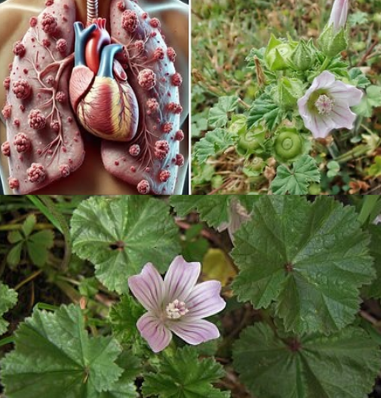
Common mallow (Malva sylvestris) might look like just another wild plant growing by the roadside, but behind its unassuming appearance lies a treasure chest of nutrients and healing potential. Used for centuries in traditional medicine, this versatile herb continues to earn its place in modern natural wellness circles. From soothing digestive issues to nurturing skin health, common mallow proves that nature’s best remedies often come in the most humble forms.
A Nutrient-Rich Herbal Powerhouse
One of the most impressive aspects of common mallow is its nutritional profile. Packed with vitamins A, C, and K, it supports immune function, skin health, and proper blood clotting. Its mineral content—especially calcium, magnesium, and potassium—plays a vital role in bone strength, muscle function, and heart health. And thanks to its antioxidant compounds, common mallow can help protect cells from free radical damage, slowing down the effects of aging and supporting overall vitality.
Gentle Support for Digestive Health
If you’ve ever experienced mild indigestion or stomach irritation, common mallow might be the natural solution you’ve been overlooking. The plant contains mucilage—a gel-like substance found in its leaves and roots—that coats and soothes the lining of the digestive tract. This makes it a gentle ally for easing discomfort, calming inflammation, and supporting regular digestion without harsh side effects.
Nature’s Anti-Inflammatory and Antioxidant
Common mallow isn’t just soothing on the inside—it’s also a potent fighter against inflammation and oxidative stress. Its flavonoids and phenolic acids work together to reduce swelling and help the body manage long-term health challenges linked to chronic inflammation. By neutralizing free radicals, it may also play a role in lowering the risk of certain diseases over time.
Video : 5 Incredible Health Benefits of Common Mallow (Malva Neglecta)
Breathing Easier with Respiratory Support
In folk medicine, common mallow has long been used to ease respiratory discomfort. Its expectorant properties help loosen and clear mucus from the lungs, making it easier to breathe during coughs, colds, or seasonal congestion. A warm tea made from the leaves and flowers can be especially comforting on chilly days when your airways need a little extra care.
Skin-Soothing and Hydrating Properties
Common mallow’s mucilage content also makes it a natural skin soother. Whether used in creams, ointments, or homemade poultices, it can help calm rashes, insect bites, and mild skin irritations. Its emollient effect locks in moisture, making it a gentle remedy for dry or sensitive skin. No wonder it’s a quiet favorite in natural skincare products.
A Nutritious Addition to the Kitchen
Beyond its medicinal uses, common mallow can also be enjoyed as food. The young leaves can be eaten raw in salads, added to soups, or lightly sautéed like spinach. They’re mild in flavor, tender in texture, and bring a boost of nutrients to everyday meals. Just remember—always harvest from clean, pesticide-free areas to ensure safety.
A Word of Caution
While common mallow is generally safe, it’s wise to consult a healthcare professional or herbalist before adding it to your wellness routine, especially if you’re pregnant, nursing, or taking prescription medications. Like any potent natural remedy, it’s best to use it in moderation and with proper guidance.
Video : Mallow Nutrition + How to Eat Common Mallow
Conclusion
Common mallow is proof that some of the most valuable plants often go unnoticed. With its wealth of nutrients, digestive support, anti-inflammatory benefits, and skin-healing potential, this humble herb deserves a closer look. Whether you sip it as a soothing tea, apply it to your skin, or toss its tender leaves into a salad, common mallow offers a gentle yet powerful way to enhance your health naturally—reminding us that sometimes, the simplest plants hold the most extraordinary gifts.


